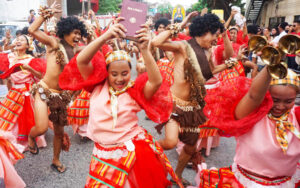
Cinnamon’s spicy warmth is enjoyed by people every Christmas. This is because cinnamon is considered Christmas in a scent aside from it being a spice. An online article entitled, “Why We Love Cinnamon at Christmas” stated that over the years, it was found that the smell and flavor of cinnamon, famous for both its scent and flavor coming from the inner bark of several species of trees in a certain genus called Cinnamomum, is made up of some 80 aromatic compounds.
In medieval times, cinnamon was used as a preservative, especially during large feasts like the ones thrown every Christmas.
But cinnamon is not just for Christmas and baking is not the only way cinnamon can be used.
A former female bank executive found this out while she was blogging about her home garden. November Canieso-Yeo was researching and writing about superfood plants that she could grow in her garden in 2016 when she stumbled upon the Philippine cinnamon and learned that the plant is considered a superfood. Canieso-Yeo found out that the cinnamon is endangered.

“I found out that there are 19 species, 7 we found in Don Salvador Benedicto in Negros Occidental. Best of all, we discovered that there is a market demand for Philippine cinnamon like Kalingag or Kaningag!” she emphasized.
Kaningag is what Negrense cinnamon farmers call the cinnamon regardless of species. In Luzon, it is called Kalingag and Karingag in Mindanao.
Cinnamon species growing in DSB include Cinnamomum iners, Cinnamomum ebaloi, Cinnamomum mercadol, Cinnamomum mendozai, Cinnamomum myrianthum, Cinnamomum rupestre and Cinnamomum nanophyllum.
Canieso-Yeo was a bank officer for 7 years before she embraced the advocacy on conservation, livelihood, health and climate change mitigation through the conservation and propagation of cinnamon species. Upon discovering that cinnamon trees naturally growing in the forests of DSB, but upland farmers, unaware about the plant and its importance, were cutting it down and some were using it to make charcoal, she saw an opportunity to help educate and enjoin farmers in conservation efforts while at the same time providing them livelihood.
“I put up Plantsville Health. You know this feeling that you’ve found something really important? Something really huge and it is something that I have been looking for actually. Of course, I had to take the dive,” the cinnamon advocate shared.
Jenny Sabiaga Bongo admitted that before the intervention, she did not know how important cinnamon trees were because some farmers would cut the trees down and to make charcoal.
“Before we were made part of the advocacy, I really did not understand the benefits of cinnamon. I thought it was just like any other tree. But now that my husband is involved in the project, specifically in the distillation process, we both appreciate the benefits of the plant. Like when my husband had sores in his foot, we applied hydrosol on it and it healed immediately. Aside from tits health benefits, we are also earning from the trees that we plant and grow,” said Bongo.


According to Canieso-Yeo, another reason why upland farmers before were cutting the trees down was they were clearing the land to replace the cinnamon and other trees with other crops like sugarcane, pineapple and vegetables. She added that of 350 farmers from 7 associations, 76 plant cinnamon. As of this writing, these cinnamon farmers have sowed 14,133 seedlings covering more or less 28,266 square meters.
“We are merely changing their business model and replacing their livelihood with harvesting of leaves, so the trees stay alive. They can harvest many times because only young leaves are harvested. Through our intervention, the farmers’ behavior changes because aside from not cutting and burning the trees, they are motivated to plant additional trees,” she explained.
Meanwhile, several researches conducted revealed that cinnamon helps control blood sugar because it has an insulin effect whereby it opens up the cells to absorb the sugar in the blood. Also, the superfood is anti-hypertension. It is a spice that helps the body to warm up. The heat produced through cinnamon consumption burns fats in the body. It also helps heal skin issues as it is anti-inflammatory.
“There was this case of a lady who had psoriasis. We gave her hydrosol and she told us that when she started to apply it on the affected parts of her body, it got healed. My aunt who has cancer has been complaining about the dryness and itchiness of her skin due to exposure to radiation because she was undergoing therapy. I also let her try spraying hydrosol on it and she was so happy because the itchiness stopped immediately, recalled Canieso-Yeo.
Mollie Alcober has been tilling the soil for 30 years and has failed many times in making his farm productive. But when he was Integrated Social Forestry (ISF) Chairman in their barangay, Canieso-Yeo spoke before farmers about cinnamon and the plant’s benefits.
“That was when my interest in the plant started. Also, I got to try cinnamon tea which was really delicious. I have been planting and growing cinnamon trees for three years now. Anyone who gets to pass by the farm and see my cinnamon seedlings, they would buy 5 to 10 seedlings. I intend to plant more cinnamon seedlings. If farmers are provided the assistance they need like fertilizer and seedling bags, we will be able plant more cinnamon,” said Alcober.
The social entrepreneur is happy that through this advocacy, they are able to provide an additional revenue stream for farmers.
“They are paid for the seedlings when I buy them. They are also paid for the leaves. Then the local government unit pays them also for planting and then recently, the Provincial Environment Management Office also bought seedlings from them for propagation purposes. We are currently studying and identifying other Philippine aromatics that we can buy from them. The ones they can plant under their cinnamon trees,” Canieso-Yeo said.
But the cinnamon is not just a holiday scent and spice, it is also one Christmas gift that will surely keep on giving. Why? First, it is sustainable. As Canieso-Yeo explains it whenever she has the chance to talk about the cinnamon, when you give a seedling as a gift, you are entrusting something to someone that is important. It will last for a long time. You can use the leaves, enjoy the air. When it grows, it will give shade and attract birds or other flora and fauna to your garden.
Second, when you buy cinnamon seedlings or products, you are buying from farmers. What a farmer earns he uses for his family. Some of his earnings he will use to help his neighbors. There is a ripple effect. That ripple effect is powerful because by buying seedlings and their products, you are able to help their whole community.
One of the quotes I got from my interview with Canieso-Yeo which I love the most is this: “When we give something good to others, it helps other people and it also makes us feel good about what we are doing, about life. If many people are doing the same thing, it becomes a virtuous cycle. My cousin told me our goal is how to place ourselves in the cycle of virtues and I agree.”
Giving something good to the world is the start of being part of a good cycle. Isn’t it an apt holiday reminder as we all prepare for advent and ready ourselves for another fresh 365.24 days?
Let us all have a happy, healthy, environment-friendly and meaningful holidays with our loved-ones. Malipayon nga Paskwa!*







